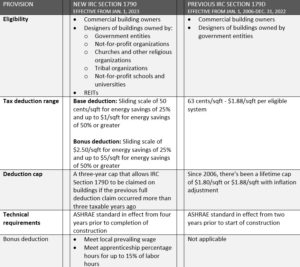
By: Chris Lambert, CPA, CGMA, CCIFP
The Inflation Reduction Act of 2022, signed into law on August 16, is designed to address energy, tax, and health policy.
The act dramatically increases the Internal Revenue Code (IRC) Section 179D energy-efficient commercial building deduction, making it especially impactful for architecture, engineering, and construction industries and commercial building owners. With the 179D commercial building deduction changes, the act incentivizes the construction and renovation of energy-efficient buildings. Here are the highlights:
Significant Increase to 179D tax deduction
Congress initially passed section 179D tax deduction as part of the Energy Policy Act of 2005 . Section 179D allows qualifying building owners and businesses to receive an immediate first-year tax deduction for a new or remodeled commercial building.
The 179D deduction will operate in its current form through year-end 2022. However, after January 1, 2023, the following changes apply.
179D tax deduction increase: For those who qualify for the 179D tax deduction, the new legislation raises the deduction value from the current maximum of $1.88 per square foot to a maximum of $5.00 per square foot, subject to an annual inflation adjustment.
The provision applies to reduced energy costs in the following three subsystems:
- Building envelope
- Heating, cooling, ventilation, and hot water systems (HVAC)
- Interior lighting systems
Currently, the 179D deduction allows taxpayers to expense improvements that improve a building’s energy efficiency by 50% compared to the American Society of Heating, Refrigerating and Air-Conditioning Engineers (ASHRAE) standards. However, partial deductions can be taken per subsystem that meet the 50% test.
Beginning in January, deductions will be available for buildings that improve energy efficiency by 25%. The deduction amount increases for every percentage point of energy efficiency above the 25% benchmark.
The base deduction starts at .50 cents per square foot for the 25% energy savings threshold and increases by 2 cents per square foot for each percentage point above that, up to $1 per square foot. In addition, contractors can earn an additional bonus deduction if they pay prevailing wages and meet apprenticeship requirements for these jobs. This bonus deduction starts at $2.50 per square foot at the 25% threshold and increases 10 cents per square foot beyond that, up to the $5 maximum.
If you’re a contractor, architect, or engineer, and you’re working on a government or not-for-profit building, the Inflation Reduction Act is encouraging you to pay prevailing wages to qualify for this benefit.
The key in that situation is to calculate how much the additional tax deduction would be versus your additional labor expense.
Who’s Eligible?
The Inflation Reduction Act extends the deduction to designers of commercial buildings owned by tax-exempt entities, including not-for-profit organizations, churches and other religious organizations, tribal organizations, and not-for-profit schools and universities.
This is in addition to current eligibility, which only includes commercial building owners and designers of buildings owned by government entities.
Compare Previous Versus Updated IRC Section 179D Provisions
The additional value and complexity of the changes to IRC Section 179D are demonstrated in the table below, which summarizes the previous state of IRC Section 179D and the changes made by the Inflation Reduction Act of 2022.

We’re Here to Help
To learn more about how the provisions in the Inflation Reduction Act of 2022 could impact your business, contact your Construction team representative or Chris Lambert, CPA, CGMA, CCIFP
